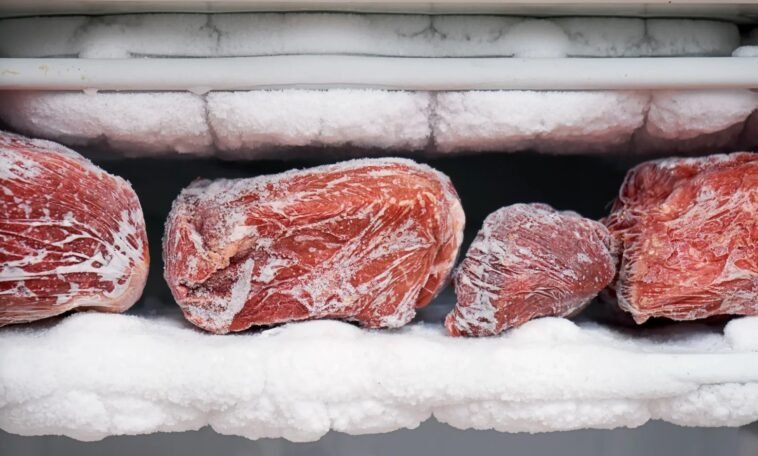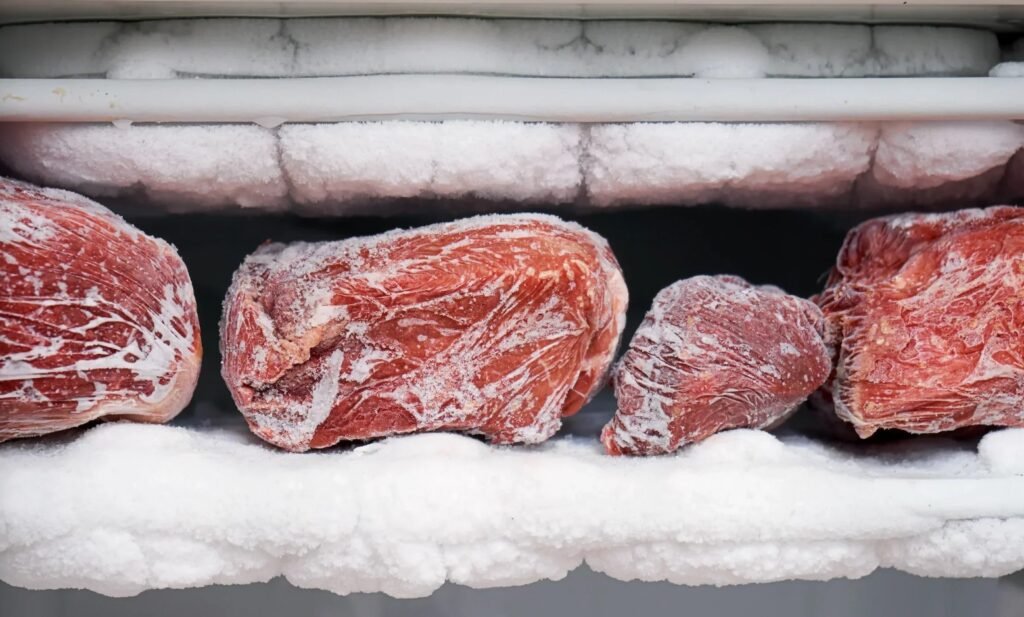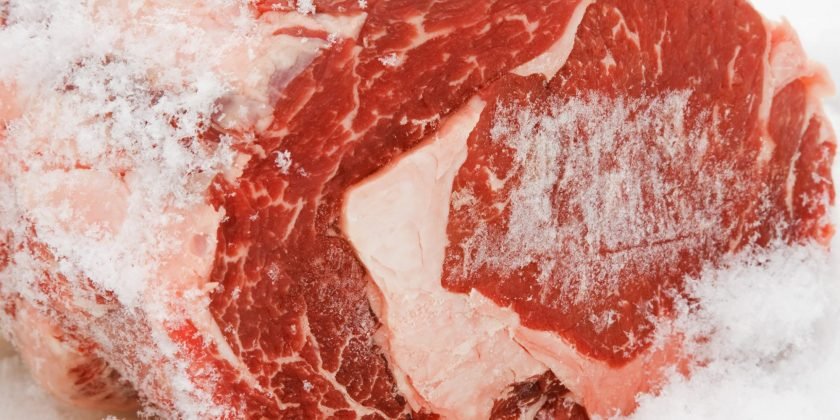Frozen meat lasts 3-12 months in the freezer, depending on the type. Beef lasts the longest, while ground meats and poultry have shorter durations.

Storing meat in the freezer is a common practice to prolong its shelf life. Understanding how long different types of meat can be safely kept frozen helps maintain quality and safety. Beef, for example, can last up to 12 months without significant loss of taste or texture.
Pork and lamb can be stored for 6-8 months, while ground meats and poultry should be used within 3-4 months. Proper packaging, such as vacuum sealing or using heavy-duty freezer bags, can help preserve the meat’s quality. Knowing these storage times ensures you enjoy your meals without compromising on flavor or safety.

Freezing Meat Basics
Freezing meat is an excellent way to extend its shelf life. By understanding the basics, you can keep your meat fresh and safe for longer periods. Let’s dive into some essential aspects, including the optimal freezer temperature and packaging techniques.
Optimal Freezer Temperature
The freezer temperature plays a crucial role in preserving meat. It should be set at or below 0°F (-18°C). This temperature keeps meat safe from harmful bacteria and slows down the spoilage process.
Using a freezer thermometer to ensure the temperature is accurate is a good idea. Consistency is key. Avoid opening the freezer door frequently, which can cause temperature fluctuations.
Packaging Techniques
Proper packaging is vital for maintaining the quality of frozen meat. Use airtight containers or heavy-duty freezer bags to prevent freezer burn.
- Wrap meat tightly in plastic wrap or aluminum foil.
- Place the wrapped meat in a sealed freezer bag.
- Remove as much air as possible from the bag before sealing.
Label each package with the type of meat and the date it was frozen. This helps in keeping track of the storage time.
For large cuts of meat, consider cutting them into smaller portions. This speeds up the freezing process and makes it easier to thaw only what you need later.
| Meat Type | Storage Time |
|---|---|
| Beef | 6-12 months |
| Pork | 4-6 months |
| Poultry | 9-12 months |
By following these tips, you can ensure your frozen meat remains in the best possible condition. Proper temperature and packaging are the keys to long-lasting meat.
Shelf Life By Meat Type
Understanding frozen meat’s shelf life is crucial for safety and quality. Each type of meat has a different lifespan in the freezer. This guide will help you know how long you can store various meats.
Beef And Pork
Both beef and pork can be stored in the freezer for up to 12 months. The key is to ensure they are properly wrapped. Use heavy-duty aluminum foil, plastic wrap, or freezer paper.
- Ground beef: Lasts up to 4 months.
- Steaks: Can be frozen for 6-12 months.
- Chops: Also good for 4-6 months.
- Roasts: Can last 4-12 months.
Poultry
Poultry has a shorter shelf life compared to beef and pork. Whole chickens or turkeys can last up to 12 months in the freezer. Parts like wings, thighs, and breasts have a shorter lifespan.
- Whole poultry: Up to 12 months.
- Poultry pieces: Last 9 months.
- Ground poultry: Up to 4 months.
Fish And Seafood
Fish and seafood have a shorter shelf life in the freezer. Fatty fish like salmon and tuna can be frozen for up to 3 months. Lean fish like cod can last up to 6 months.
| Type | Shelf Life |
|---|---|
| Fatty fish (salmon, tuna) | 3 months |
| Lean fish (cod, haddock) | 6 months |
| Shrimp, scallops, squid | 3-6 months |
| Lobster, crab | 6 months |
Signs Of Freezer Burn
Freezer burn can affect the quality of your frozen meat. Identifying the signs early helps maintain its taste and texture. Learn how to spot freezer burn and understand its impact.
Visual Indicators
Freezer burn is often visible. Look for these visual signs:
- Grayish-brown spots on the meat surface
- Ice crystals forming on the meat
- Dry or leathery appearance
These indicators suggest the meat has been exposed to air. This exposure causes dehydration.
Texture And Taste Changes
Freezer burn affects the texture and taste of your meat. Notice these changes:
- Meat becomes tough or chewy
- The flavor becomes bland or off
- Meat feels dry even after cooking
These changes occur because moisture has left the meat. The quality is compromised.
Preventing Freezer Burn
Freezer burn can ruin the taste and texture of your meat. It’s important to know how to prevent it. Freezer burn happens when air reaches the food’s surface and dries it out. This can be avoided with proper techniques.
Proper Wrapping Methods
Wrapping meat correctly is the first step to prevent freezer burn. Use airtight packaging to keep air out. Here are some methods:
- Plastic Wrap: Wrap the meat tightly in plastic wrap. Then, cover it with aluminum foil.
- Aluminum Foil: Wrap the meat in heavy-duty aluminum foil. Make sure it is fully covered.
- Freezer Paper: Place the meat on freezer paper. Fold the edges over and tape them down.
Using these methods ensures that no air can reach your meat. This keeps it fresh for longer periods.
Using Vacuum Sealers
Vacuum sealers are excellent for preventing freezer burn. They remove all air from the packaging. This keeps the meat fresh and tasty.
- Prepare the Meat: Cut the meat into portions. Place each portion in a vacuum sealer bag.
- Seal the Bag: Use the vacuum sealer to remove the air. Seal the bag tightly.
- Label and Freeze: Label the bag with the date. Place it in the freezer.
Vacuum sealing is one of the best methods for preserving meat. It keeps the meat in excellent condition for longer periods.
Thawing Frozen Meat
Thawing frozen meat properly is crucial for food safety and taste. There are three main methods to thaw frozen meat. Each method has its pros and cons. Choose the best method that suits your needs.
Refrigerator Thawing
Refrigerator thawing is the safest way to thaw meat. It keeps the meat at a safe, consistent temperature. Place the frozen meat on a plate or in a container. This prevents any juices from contaminating other foods.
Thawing meat in the refrigerator takes time. A large roast may take up to 24 hours to thaw. Smaller cuts like chicken breasts or ground beef will thaw overnight. Plan ahead and allow enough time for this method.
Cold Water Thawing
Cold water thawing is faster than refrigerator thawing. It requires more attention. Place the frozen meat in a leak-proof plastic bag. Submerge the bag in cold tap water. Change the water every 30 minutes.
A small package of meat may thaw in an hour or less. Larger cuts could take 2-3 hours. Cook the meat immediately after thawing using this method.
Microwave Thawing
Microwave thawing is the quickest method. It can be tricky. Place the meat on a microwave-safe plate. Use the defrost setting on your microwave.
Monitor the meat closely. Microwave thawing can begin to cook the meat’s edges. This method should be used only if you plan to cook the meat right away.
Refreezing Thawed Meat
Freezing meat helps keep it fresh for longer. But what happens when you thaw it and need to freeze it again? Understanding the rules for refreezing thawed meat is crucial to ensure safety and maintain quality.
Safety Guidelines
Refreezing thawed meat can be safe if done correctly. Here are key safety tips:
- Thaw in the refrigerator: Always thaw meat in the fridge. This keeps it at a safe temperature.
- Time limit: Refreeze meat within 2 days of thawing.
- Check temperature: Make sure the meat stays at or below 40°F.
Never refreeze meat left out at room temperature. This increases the risk of bacteria growth.
Quality Considerations
Refreezing meat may affect its quality. Here are some points to consider:
| Quality Aspect | Impact |
|---|---|
| Texture | Meat may become mushy |
| Flavor | Possible loss of flavor |
| Moisture | Meat can dry out |
To minimize quality loss, follow these steps:
- Wrap tightly: Use airtight packaging to prevent freezer burn.
- Use quickly: Consume refrozen meat within a few months.
- Proper thawing: Thaw meat in the fridge before cooking.
Refreezing thawed meat is safe if you follow these guidelines. While quality may decrease, proper handling can help preserve your meat’s texture and flavor.
Storage Tips For Quality
Proper storage of frozen meat helps maintain its quality and taste. Follow these storage tips to ensure your meat stays fresh for longer. Learn how to organize your freezer and label your meat properly.
Organizing Your Freezer
Keep your freezer organized to find what you need quickly. Use clear containers and freezer bags to store meat.
- Place older meat at the front.
- Use bins or baskets for different types of meat.
- Keep similar items together for easy access.
Labeling And Dating
Label and date your meat to track storage time. This helps you use the oldest meat first.
- Write the type of meat on the label.
- Add the freezing date.
- Use waterproof markers to prevent smudging.
You can keep your frozen meat fresh and organized with these simple steps. Enjoy high-quality meat whenever you need it.

Expert Recommendations
Understanding how long frozen meat lasts is crucial for safety. Experts provide guidelines to ensure your meat stays fresh and safe. Following these recommendations can save you from foodborne illnesses. Let’s explore what trusted sources say and debunk common myths.
Trusted Sources
Several trusted sources offer guidelines on freezing meat. The USDA and FDA are reliable authorities.
| Type of Meat | Recommended Freezing Duration |
|---|---|
| Raw Ground Meat | 3-4 months |
| Raw Steaks | 6-12 months |
| Raw Poultry | 9-12 months |
| Cooked Meat | 2-3 months |
Freezing meat properly can extend its shelf life. Always follow these guidelines to avoid spoilage.
Common Myths Debunked
Many myths exist about freezing meat. Let’s debunk some of them.
- Myth: Freezing kills all bacteria.
- Fact: Freezing only inactivates bacteria. They can become active when thawed.
- Myth: Meat can be refrozen without any issues.
- Fact: Refreezing meat affects its quality. It may become dry and lose flavor.
- Myth: Freezer burn makes meat unsafe.
- Fact: Freezer burn affects texture and taste but not safety.
Understanding these myths helps you make informed decisions. Trust the experts and reliable guidelines. This ensures your frozen meat remains safe and delicious.
Frequently Asked Questions
When To Throw Out Frozen Meat?
Throw out frozen meat if it’s been in the freezer for over a year. Check for freezer burn or off smells.
Can Frozen Beef Go Bad In The Freezer?
Yes, frozen beef can go bad in the freezer. It lasts up to 12 months if stored properly. Always check for freezer burn and off smells before cooking.
Is 2-Year-Old Frozen Meat Safe To Eat?
Frozen meat stored at 0°F can remain safe to eat for years. Quality may degrade over time. Check for freezer burn.
How Long Can You Keep Frozen Food In The Freezer Before It Goes Bad?
Frozen food can last 3 to 12 months in the freezer, depending on the type. Proper storage is key.
Conclusion
Understanding how long frozen meat lasts ensures food safety and quality. Proper storage extends meat’s shelf life. Label and date packages to keep track. Thaw meat safely in the refrigerator. Enjoy fresher meals and avoid waste by following these guidelines.
Take care of your health by managing your frozen meat wisely.


GIPHY App Key not set. Please check settings